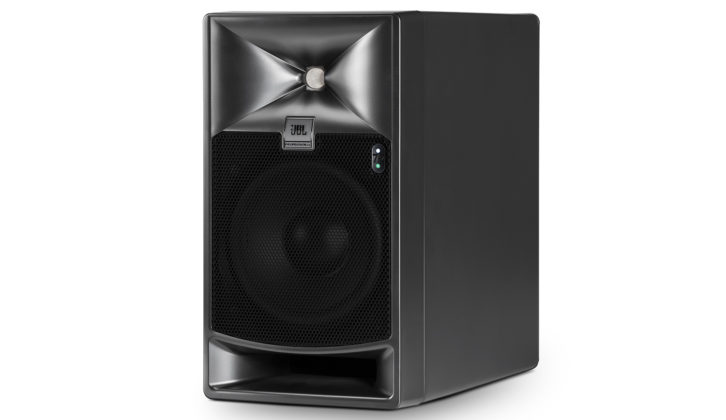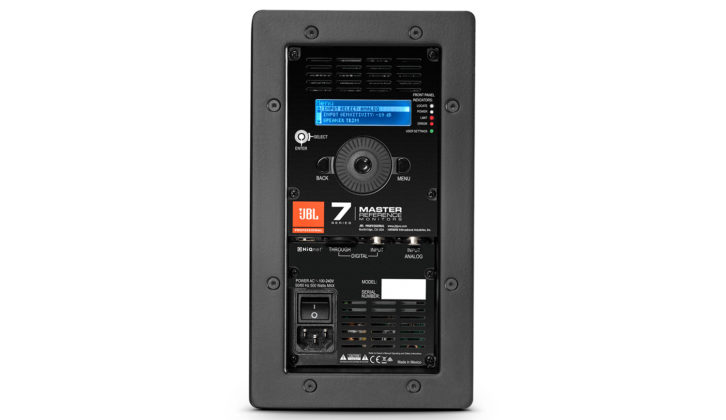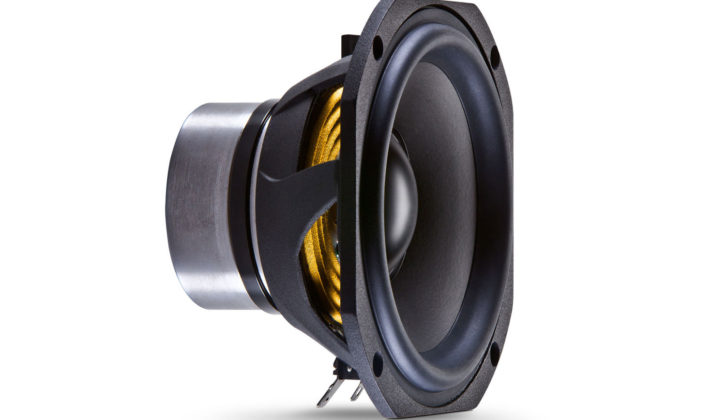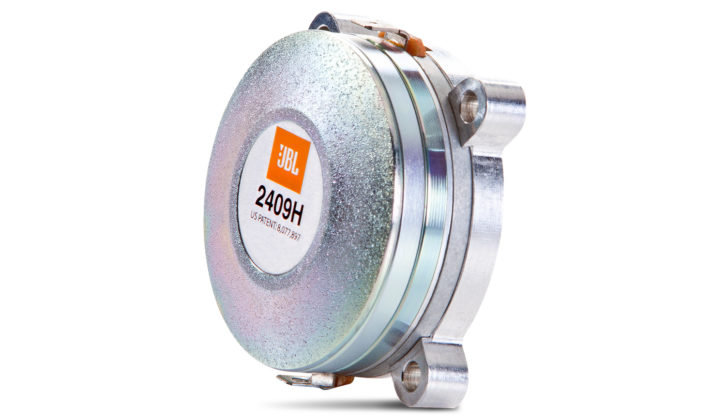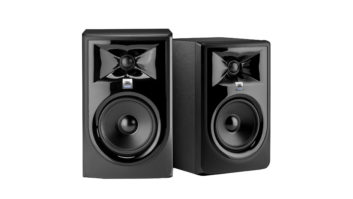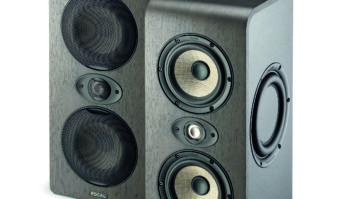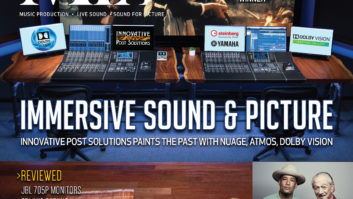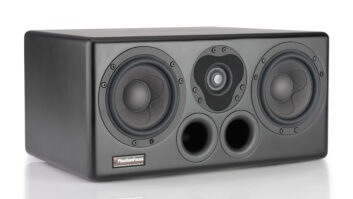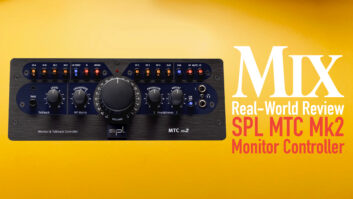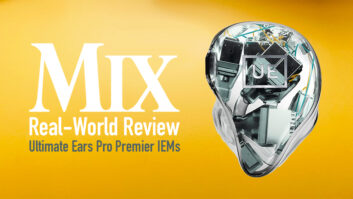JBL’s 7 Series takes advantage of technology developed for the company’s flagship M2 Master Reference Monitor and comes in at a much more accessible price. The 7 Series’ patented Image Control Waveguide, introduced in the M2, was developed to provide a wide, precise stereo image while ensuring a seamless transition between the low- and high-frequency drivers.
Proprietary transducers, meanwhile, were designed for increased output, extended low-end response and reduced power compression. As the model numbers suggest, the 705 employs a 5-inch low-frequency driver while the 708 uses an 8-inch driver. Both models utilize a JBL 2409H annular diaphragm compression driver.
The 7 Series consists of four models: the 705i and 708i are passive designs introduced in late 2014 system for fixed installations. JBL unveiled the active “P” versions last year to satisfy the broad range of customers who need self-powered speakers.
Each speaker has onboard bi-amplification optimized for the drivers, with a 250-watt amp dedicated to each transducer — the result of which is said to be extremely high output and resolution even when listening from the mid-field. The active architecture also enabled JBL engineers to incorporate DSP-based room equalization for tailoring the cabinet response to placement, or compensate for acoustic issues in the listening environment. The 705P and 708P provide AES/EBU digital inputs for direct connection to DAW hardware at sample rates up to 192 kHz. For this review JBL sent Mix a pair of 705Ps.
Connectivity
The rear panel of the 705P features balanced XLR analog and AES3 digital inputs, an AES3 thru connection for daisy-chaining a second speaker and subwoofers, Harman HiQnet port, and an IEC power inlet. An LCD screen displays system information, and a data wheel with a concentric Enter key, plus Back and Menu keys, facilitates navigation and setting of system parameters. [Editor’s Note: JBL has announced the availability of a 7 Series software application that utilizes the HiQnet port to allow setup and live control of multispeaker systems from the mix position. The software is compatible with Mac, Windows, iOS and Android computers and tablets.]
The birch-ply cabinet is compact, heavy and solid, and almost twice as deep as it is wide—allowing it to house the electronics, yet be slim enough to avoid interference with control room displays. Two LEDs on the front panel indicate power and EQ/delay status. A non-removable steel grille protects the woofer cone; directly below is a Slip Stream Port said to maintain low-frequency accuracy at all playback levels while reducing turbulence. Threaded inserts make the speaker easy to mount.
The 705P has an extensive menu of onboard DSP options, including user EQ (high and low-shelf plus four bands of parametric EQ), room EQ, factory and user EQ presets, variable HPF (60, 70, 80, 100 or 120 Hz), frame (A/V sync) delay, room delay, analog input trim, and AES level trim. At first I left the EQ flat and the HPF disengaged.
Time to Listen
I connected the 705Ps to my Dangerous Monitor ST using the analog XLR inputs. Input sensitivity was set to +4 dBU, and input trim was set to 0. The speakers were placed in the usual location for my control room: on stands approximately 36 inches high and 4.5 feet apart, at the same distance from the listening position and about 16 inches from the front wall. When powered up, the two front-panel LEDs briefly blink on and off; after a few moments, the top LED glows steady white to indicate normal operation. When EQ or delay settings deviate from normal, the lower LED lights steady green.
Listening to the 705Ps for the first time was a bit surprising: I didn’t expect that a box this size would produce such a big bottom end. Having said that, don’t expect to shake the studio foundation with your latest House mix—usable response rolls off pretty quickly below about 40 Hz. Still, the low-end reproduction is tight, accurate and balanced with the rest of the frequency range. You never get the impression of “fake,” colored bass trying to fool you into thinking the box produces more than it really does.
The low end is quite noticeable at first, but one of the 705P’s strengths is the midrange. Vocals sounded natural, and I felt like the speakers were telling the truth about what I was recording. Ditto for acoustic guitar, snare drum and piano. I did feel like some of the bottom end was missing from kick drum or Moog-type synth tracks. Cymbals and percussion were crisp and clear but not fatiguing, and transients from sidestick and shaker were produced with a lot of realism. The 705Ps were able to produce SPLs into the mid-90s (C-weighted) while maintaining their clarity and transparency.
Mixing songs on the 705Ps presented a bit of a challenge because I initially found that taking my mixes elsewhere translated to a bit too much bottom end. This could be due to the fact that I’m accustomed to using a subwoofer in my control room. With response into the 30Hz range, the speaker was designed to deliver extension and output of larger speakers. It might just take getting used to if you normally have a sub firing in your system. Regardless, the mixes were otherwise in the ballpark, so I decided to use the onboard EQ to bump the low-frequency response up a hair and try additional mixes.
Related: JBL LSR305 Powered Studio Monitor, by Michael Cooper, Mix, Nov. 26, 2014
I started with a low-shelf EQ of +2 dB at 95.1 Hz with a 3dB slope, then ultimately changed it to +2 dB at 69.2 Hz with a 6dB slope. I wasn’t comfortable using the parametric bands (parametric vs. shelf is selectable in the Room EQ settings). I find that messing with a speaker’s response often results in more harm than good, and quite frankly I don’t like the audible phase shift caused by most loudspeaker correction. In any case the Low Shelf adjustment was exactly what the doctor ordered because the mixes I did after that small adjustment translated very well.
I was able to easily save my EQ as a user preset, but make note of the fact that loading a preset does not automatically engage (enable) the EQ. If the EQ was disengaged (bypassed) before loading the preset, you will have to engage it in order to hear the effects.
Using the EQ or HPF causes the lower LED on the front panel to glow steady green. According to the manual, “Persistent green LED indicates EQ, Delay and other processing are enabled,” but I found the implementation to be inconsistent. If you alter the frame delay value, the green LED illuminates even if the frame delay is disengaged, but changing the speaker delay value does not illuminate the green LED until you engage that particular function. Ugh!
I’d prefer that the LED glowed yellow to indicate a state other than factory preset. The rear-panel LCD helps you navigate the menus, but I found it difficult to read (there’s no adjustment for contrast), and the data wheel on one of the speakers would sometimes skip quickly through a menu.
The Verdict
With the introduction of the 705P Master Reference Monitor, JBL has created an excellent studio monitor that takes the guesswork out of choosing an amplifier and will be at home in any professional audio environment. I can easily see this loudspeaker becoming popular with post houses and mix rooms where space is at a premium, and accuracy is a necessity.
Related: The Making of a Monitor: An Inside Look at How JBL Developed the M2 and Re-ignited Its Studio Line, by Tom Kenny, Mix, Oct. 1, 2013
The 705P Master Reference Monitor won’t rock your chair with earthquake sound effects but more importantly the frequency range that it does produce is accurate and uncolored. In particular, the midrange is spot-on. I found getting vocal balances, reverbs and delays right on the 705Ps was easy, and the minor tweak to the low-end EQ helped me create mixes that traveled well. They might not be the first choice for hip-hop artists who need tons of bottom, but anyone who prefers accuracy over the ultimate in low end extension should check out the705Ps. Hip Hop producers might want to check out the 708P 8-inch model.
Steve La Cerra, a New York–based recording and live sound engineer, is Mix’s technology editor, live sound.
Product Summary
Company: JBL Professional
Product: 705P Bi-Amplified Master Reference Monitor
Website: www.jblpro.com/7series
Price: $1,249 each (MSRP)
Pros: Excellent sound; compact footprint; compatible with Harman HiQnet, digital input accepts sample rates up to 192 kHz
Cons: Status LEDs are confusing; LCD screen is difficult to read; data wheel can be a bit touchy.
